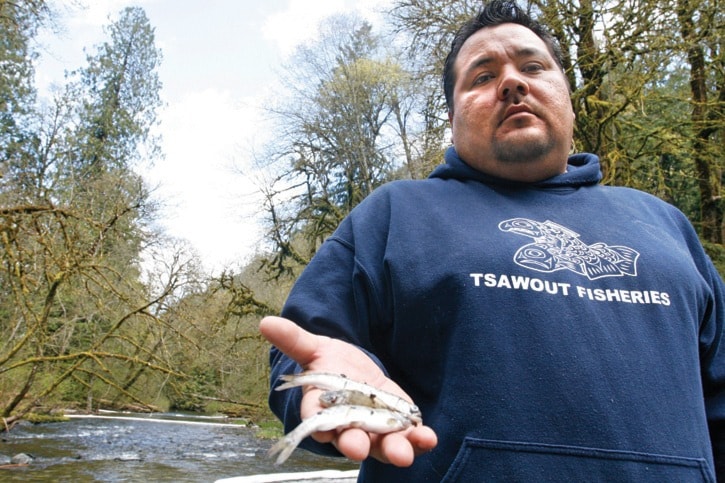Fish biologists are fearful for the future of the Goldstream salmon run after a tanker truck released 30,000 litres of gasoline into the river Saturday.
“On a scale of one to 10, it’s pretty bad. It’s a 9.5,” said Ian Bruce, fishery biologist for Tsawout First Nation and Peninsula Stream Society. “There are dead fish up and down the river.”
Fish species impacted include chum, coho, chinook and steelhead salmon. Department of Fisheries and Oceans issued a temporary emergency closure of the harvest of shellfish including clams, oysters and mussels in Finlayson Arm and Saanich Inlet due to the spill.
Just hours before the crash, Goldstream hatchery volunteers and Tsawout First Nations members had released 8,000 coho salmon into the river. Earlier last week the hatchery had released an additional 20,000 salmon.
“That is about 30,000 coho that are not safe and are at risk,” said Peter McCully a fisheries biologist with the Goldstream hatchery. “It’s heartbreaking.”
The hatchery still has fish to release, but McCully said that won’t happen until the river is deemed safe. While picking up a dead coho fry from a bucket, McCully shows a clipped adipose fin, an indicator the fish came from the hatchery.
“This represents a huge amount of work, it was wiped out,” McCully said who has been working at the hatchery for 35 years.
Last year’s coho return was the lowest McCully had ever seen. With with Saturday’s spill wiping out possibly thousands of coho, he is unsure what the future will bring.
Tsawout First Nations fisheries manager Dan Claxton walked the lower end of the river Sunday and Monday and said its likely thousands of emerging chum fry and coho smolts have perished.
“It’s just devastating to see that many fish gone. If you look under the banks and logs, there are lots of dead fish,” Claxton said Monday morning. “Our First Nation relies heavily in the chum. We harvest chum to fill our smoke houses to get us through the winter.”
The true effects of this spill will only be seen and understood when survivors return to spawn. The coho and chum are expected back in 2012 while the steelhead may not return until 2014.
“I don’t think there is anyway they will be able to survive this,” McCully said.
It’s not just the fish that are dying from this accident. Bruce has been finding dead caddisfly, an insect that lives in the river and are food to fish.
“The impact is not just on the fish, but on the (entire) river,” Bruce said.
“This is not a good situation,” confirmed Graham Knox, manager of the environmental emergency program with the Ministry of Environment. “We have been finding hundreds of (dead) fish. Typically you find 10 per cent so that tells us there are likely thousands of fish (that have died.)”
For ocean-based oil spills, it is common to see crews in the water scrubbing rocks, Knox said, but in this case, having people in the river cleaning rocks would do more harm than good.
“This gasoline is very toxic. It evaporates and dissipates quickly,” Knox said. “We want to achieve a net environmental benefit. We don’t want to go in with 300 people tromping though the water.”
Columbia Fuels, which owns the crashed truck, has been ordered to perform an environmental impact study.
In meantime, spill booms are in the river to absorb hydrocarbons. “Every minute that goes by this is being cleansed and diluted,” Knox said.
While wading in the stream, Bruce brought gasoline sheens to the surface by disturbing the river bed. “I lifted up some rocks and it smells pretty bad,” Bruce said.
“You can smells pockets of fuel and if you lift up rocks you can see a sheen,” Claxton said.
The Goldstream hatchery has 70,000 coho and 100,000 chum to release. McCully said that number isn’t significant in solving what’s been lost.
“Of those 70,000 coho, all things being equal, if they have a chance in the ocean, I’d be surprised if two to three per cent would come back.”
reporter@goldstreamgazette.com
--with files from Edward Hill
